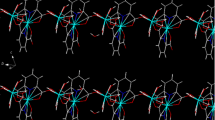Abstract
A novel solid-state reaction involving [Ni6(N2H4)6(SO4)4(OH)2(H2O)8](SO4)(H2O)10 has been used to prepare nickel nanoparticles. The reaction of [Ni6(N2H4)6(SO4)4(OH)2(H2O)8](SO4)(H2O)10 via NaOH, KOH, and/or Na2CO3 as a reactant was carried out in the solid state. The complex undergoes an intramolecular two-electron oxidation–reduction reaction at room temperature, producing metallic nickel nanoparticles (Ni1, Ni2 and Ni3). The aforementioned complex contains nickel(II) that is an oxidizing agent and also hydrazine ligand as a reducing agent. Other products produced include sodium azide and ammonia gas. The nickel metal nanoparticles were characterized using X-ray powder diffraction, scanning electron microscopy, and vibrating sample magnetometer. The synthesized nickel nanoparticles have similar morphologies; however, their particle size distributions are different.




Similar content being viewed by others
References
Anbar M (1965) Oxidation or reduction of ligands by metal ions in unstable states of oxidation. In: Kleinberg J, Murmann RK, Fraser RTM, Bauman J (eds) Mechanisms of inorganic reactions, vol 49. American Chemical Society, Washington
Balaz P (2008) Mechanochemistry in nanoscience and minerals engineering. Springer, Berlin
Beyer MK, Schaumann HC (2005) Mechanochemistry: the mechanical activation of covalent bonds. Chem Rev 105:2921–2948
Blackman JA (2009) Metallic nanoparticles. In: Misra P (ed) Handbook of metal physics. Elsevier, Amsterdam
Boldyre VV, Tkacova K (2000) Mechanochemistry of solids: past, present, and prospects. J Mater Synth Process 8:121–132
Busch DH (1963) Reactions of coordinated ligands and homogeneous catalysis. American Chemical Society, Washington, D. C.
Constable ΕC (1996) Metals and ligand reactivity. Wiley-VCH Verlag, New York
Cushing BL, Kolesnichenko VL, OConnor CJ (2004) Recent advances in the liquid-phase syntheses of inorganic nanoparticles. Chem Rev 104:3893–3946
Dilworth JR (1976) The coordination chemistry of substituted hydrazines. Coord Chem Rev 21:29–62
Fernandez-Bertran JF (1999) Mechanochemistry: an overview. J Pure Appl Chem 71:581–586
Gong W, Li H, Zhao Z, Chen J (1991) Ultrafine particles of Fe Co, and Ni ferromagnetic metals. J Appl Phys 69:5119–5121
Gubin SP (2009) Magnetic nanoparticles. Wiley-VCH, Verlag
Guo L, Liu C, Wang R, Xu H, Wu Z, Yang S (2004) Large-scale synthesis of uniform nanotubes of a nickel complex by a solution chemical route. J Am Chem Soc 126:4530–4531
Gustafsson M, Fischer A, Llyukhin A, Maliari M, Nordblad P (2010) Novel polynuclear nickel(II) complex: hydrazine, sulfato, and hydroxo bridging in an unusual metal hexamer crystal structure and magnetic properties of [Ni6(N2H4)6(SO4)4(OH)2(H2O)8](SO4)(H2O)10. Inorg Chem 49:5359–5361
Herzer G (1990) Grain-size dependence of coercivity and permeability in nanocrystalline ferromagnets. IEEE Trans Magn 26:1397–1402
Herzer G (1997) Nanocrystalline soft magnetic alloys. In: Buschow KHJ (ed) Handbook of magnetic materials, vol 10. Elsevier, Amsterdam, pp 415–462
House JE Jr (1993) Mechanistic considerations for anation reactions in the solid state. Coord Chem Rev 128:175–191
Hysen T, Al-Harthi S, Al-Omari IA, Geetha P, Lisha R, Ramanujan RV, Sakthikumar D, Anantharaman MR (2013) Annealing induced low coercivity, nanocrystalline Co–Fe–Si thin films exhibiting inverse cosine angular variation. J Magn Magn Mater 341:165–172
Kahani SA, Jafari M (2009) A new method for preparation of magnetite from iron oxyhydroxide or iron oxide and ferrous salt in aqueous solution. J Magn Magn Mater 321:1951–1954
Kahani SA, Sabeti M (2011) The mechanochemical oxidation of thiocyanate to polythiocyanogen (SCN)n using peroxydisulphate. J Inorg Organomet Polym 21:458–464
Kurzawa J, Janowicz K, Suszka A (2001) Stopped-flow kinetic determination of thiocyanates and thiosulphates with the application of iodine-azide reaction. Anal Chim Acta 431:149–155
Liu JP, Fullerton E, Gutfleisch O, Sellmyer DJ (2009) Nanoscale magnetic materials and applications. Springer, Berlin
Nakamoto K (1997) Infrared and Raman spectra of inorganic and coordination compounds, part B, 5th edn. Wiley, New York
Nicholls D, Swindells R (1968) Hydrazine complexes of nickel(II) chloride. J Inorg Nucl Chem 30:2211–2217
Papaefthymioua GC (2009) Nanoparticle magnetism. Nano Today 4:438–447
Roduner E (2006) Nanoscopic materials size-dependent phenomena. The Royal Society of Chemistry, Cambridge
Schmidt E (1984) Hydrazine and its derivatives. Wiley, New York
Sunagawa I (2005) Crystals growth, morphology, and perfection. Cambridge University Press, Cambridge
Taube H (1984) Electron transfer between metal complexes-retrospective. Science 226:1028–1036
Acknowledgments
The authors are grateful to University of Kashan for supporting this work by Grant No. 256736/6.
Author information
Authors and Affiliations
Corresponding author
Rights and permissions
About this article
Cite this article
Kahani, S.A., Khedmati, M. The preparation of nickel nanoparticles through a novel solid-state intramolecular reaction of polynuclear nickel(II) complex. J Nanopart Res 16, 2544 (2014). https://doi.org/10.1007/s11051-014-2544-6
Received:
Accepted:
Published:
DOI: https://doi.org/10.1007/s11051-014-2544-6




